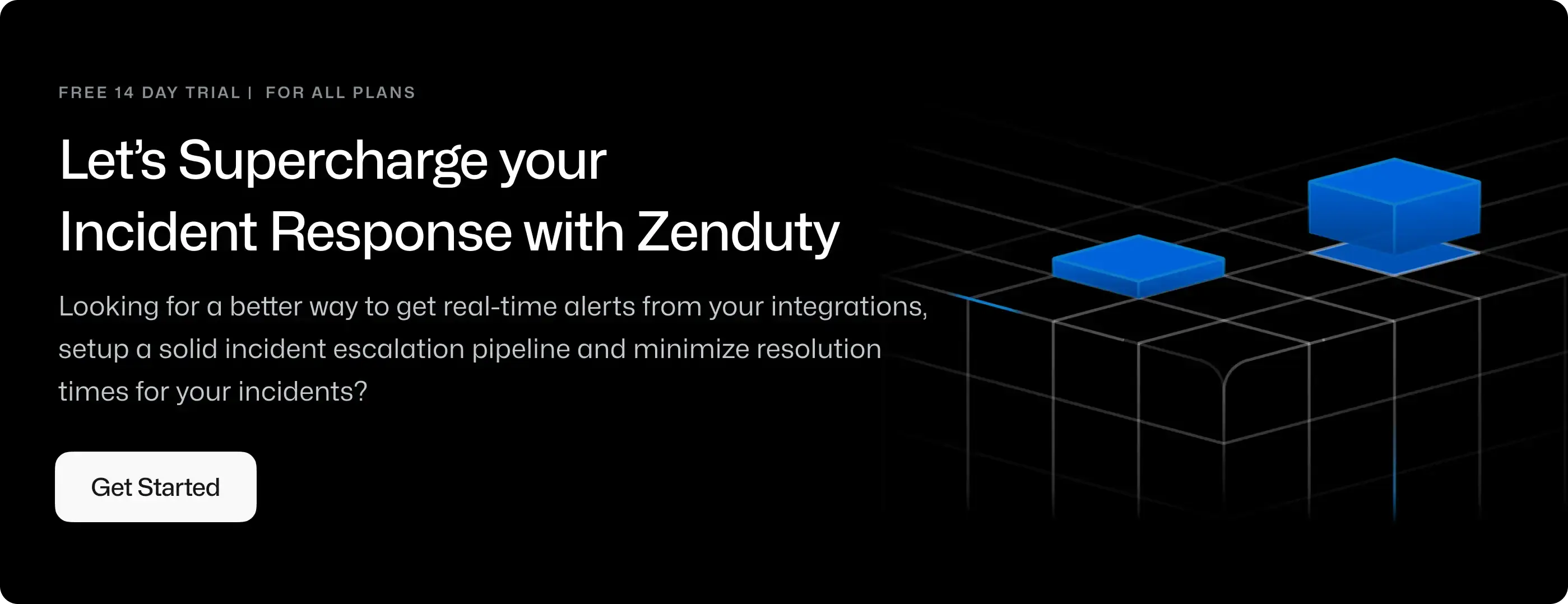Uptrends Integration Guide
Uptrends is a monitoring service to monitor website uptime, optimize performance and monitor multiple steps.
What can Zenduty do for Uptrends users?
With Uptrends Integration, Zenduty sends new Uptrends alerts to the right team and notifies them based on on-call schedules via email, text messages(SMS), phone calls(Voice), Slack, Microsoft Teams and iOS & Android push notifications, and escalates alerts until the alert is acknowledged or closed. Zenduty provides your NOC, SRE and application engineers with detailed context around the Uptrends alert along with playbooks and a complete incident command framework to triage, remediate and resolve incidents with speed.
Whenever Uptrends triggers an alert based on a predefined condition, Zenduty will create an incident. When that condition goes back to normal levels, Zenduty will auto-resolve the incident.
You can also use Alert Rules to custom route specific Uptrends alerts to specific users, teams or escalation policies, write suppression rules, auto add notes, responders and incident tasks.
To integrate Uptrends with Zenduty, complete the following steps:
In Zenduty:
-
To add a new Uptrends integration, go to Teams on Zenduty and click on the team you want to add the integration to.
-
Next, go to Services and click on the relevant Service.
-
Go to Integrations and then Add New Integration. Give it a name and select the application Uptrends from the dropdown menu.
-
Go to Configure under your Integrations and copy the Webhook URL generated.
In Uptrends:
-
Login to Uptrends. Navigate to Alerting > Integrations > Add Integration.
-
Click on Add Integration and select Uptrends Integration to create a webhook integration.

-
After naming the integration, under the predefined variable, paste the Webhook URL which you have copied earlier against the variable ApiUrl.

-
Click on the Customizations tab. Select all 3 alert types for which it should send notifications.

Keep the Content-Type as application/json. Add following schema as the alert payload:
{ "alert": { "alertGuid": "{{@alert.alertGuid}}", "type": "{{@alert.type}}", "description": "{{@JsonEncode({{@alert.description}})}}", "failureMessage": "{{@alert.failureMessage}}", "timestampUtc": "{{@alert.timestampUtc}}", "timestamp": "{{@alert.timestamp}}", "timestampUtcFormatted": "{{@alert.timestampUtcFormatted}}", "timestampFormatted": "{{@alert.timestampFormatted}}", "firstErrorUtc": "{{@alert.firstErrorUtc}}", "firstError": "{{@alert.firstError}}", "firstErrorUtcFormatted": "{{@alert.firstErrorUtcFormatted}}", "firstErrorFormatted": "{{@alert.firstErrorFormatted}}", "firstErrorCheckUrl": "{{@alert.firstErrorCheckUrl}}", "firstErrorCheckId": "{{@alert.firstErrorCheckId}}", "serverIpv4": "{{@alert.serverIpv4}}", "serverIpv6": "{{@alert.serverIpv6}}", "resolvedIpAddress": "{{@alert.resolvedIpAddress}}", "responseBody": "{{@JsonEncode({{@alert.responseBody}})}}", "downtimeDuration": "{{@alert.downtimeDuration}}" }, "alertDefinition": { "guid": "{{@alertDefinition.guid}}", "name": "{{@alertDefinition.name}}" }, "escalationLevel": { "id": "{{@escalationLevel.id}}", "message": "{{@escalationLevel.message}}" }, "incident": { "key": "{{@incident.key}}" }, "monitor": { "guid": "{{@monitor.monitorGuid}}", "name": "{{@monitor.name}}", "type": "{{@monitor.type}}", "url": "{{@monitor.url}}", "notes": "{{@JsonEncode({{@monitor.notes}})}}", "dashboardUrl": "{{@monitor.dashboardUrl}}", "editUrl": "{{@monitor.editUrl}}" }, "account": { "id": "{{@account.accountId}}" }, "source": "Uptrends", "version": "1.0" }
-
Finally, save the new webhook.
-
In the Alerting dropdown, click on the Alert Definitions button. You can create a new alert definition or update the existing one.
-
In the alert definition, select the newly created webhook in the Alerting By Integrations section and then save.

-
Uptrends is now integrated. Zenduty will create an incident for each Alert type alerts and will auto resolve the incident when uptrends sends the Ok alerts.
